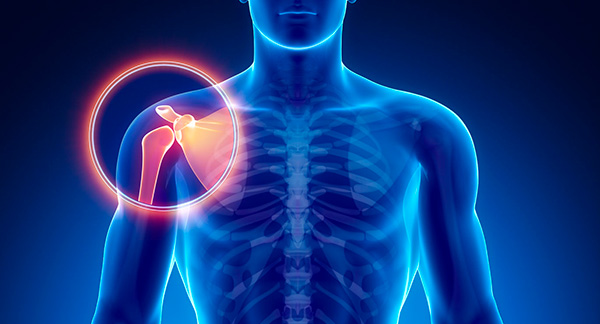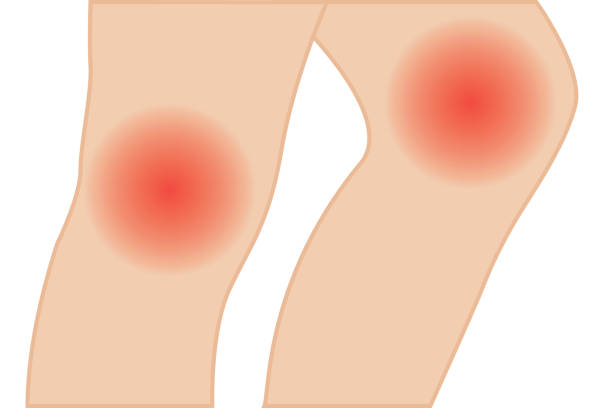



Shoulder arthritis, characterized by joint inflammation and cartilage loss, brings symptoms like pain, stiffness, and reduced range of motion. Treatments vary from home remedies to surgical interventions.
What is shoulder arthritis?
Shoulder arthritis, marked by inflammation in the joint, induces pain and stiffness, especially during arm movements. The primary joint involved is the glenohumeral joint, a “ball and socket” structure where the humerus connects with the scapula. Additionally, arthritis can affect the acromioclavicular joint (AC joint) where the collarbone meets the shoulder blade. Over time, arthritis causes cartilage deterioration, leading to bone-on-bone contact and loss of the protective cushioning between bones.
What does shoulder arthritis feel like?
If you have shoulder arthritis, you’ll feel mild-to-severe pain and stiffness in your shoulder. Over time, you’ll notice a loss in your range of motion in your shoulder joint, especially if the glenohumeral joint is involved.
You may feel pain when you reach overhead, lift heavy objects or play sports or join in activities that involve a range of arm movements. In late-stage disease, you may not be able to complete simple everyday tasks without pain. These tasks include such things as bathing, grooming and even writing or using your computer.
Where in the shoulder is pain felt and what might it mean?
The location of your shoulder pain may help tell which shoulder joint is affected.
*If you experience pain on the side of your shoulder, and the discomfort feels deep within the joint, it is likely associated with your glenohumeral joint.
*If you are experiencing pain at the top of your shoulder that occasionally radiates to the side of your neck, it is likely related to your acromioclavicular (AC) joint.
Who gets shoulder arthritis?
Shoulder arthritis:
*Is more common in people over age 50.
*Happens in younger people with rheumatoid arthritis or after shoulder trauma, such as from broken shoulder bones, shoulder dislocation or infection.
Symptoms and Causes
What are the signs and symptoms of shoulder arthritis?
Symptoms of shoulder arthritis vary among individuals and may include the following signs.
*Pain in your shoulder joint: This is the most common symptom. Initially, you may experience shoulder pain only during activity. As the disease progresses, you may feel pain at any time of the day, regardless of arm movement. The pain may intensify when lifting heavy objects or after exercise. In cases of severe arthritis, the pain may extend down your arm and even reach your elbow or wrist.
*Stiffness and loss of range of motion: Stiffness in your shoulder and a reduction in range of motion may occur. These symptoms can impede everyday tasks like dressing, bathing, driving, or doing housework.
*Grinding, clicking, popping or cracking in your shoulder joint: The noises, such as popping, clicking, and grinding, result from the loss of cartilage, creating an uneven surface. These sounds can occur with or without associated pain.
*Loss of sleep: Finding a comfortable sleeping position is challenging, as any shoulder movement can induce pain. If you sleep on your back, consider placing a pillow under the elbow of the affected side to provide support and alleviate strain on supporting joint structures. Some individuals find relief by sleeping in a recliner at night.
What causes shoulder arthritis?
Shoulder arthritis has many possible causes. They include:
*Osteoarthritis: This is the most prevalent form of arthritis, characterized by age-related wear and tear on the joints. Cartilage undergoes softening, cracking, flaking, or fraying, eventually wearing away. This exposes the underlying bones, leading to friction or grinding between them. Similar to uneven wear on car tires, joint surfaces don’t erode uniformly or at a consistent rate.
*Rheumatoid arthritis:This is an autoimmune condition, where the body’s immune system targets its own healthy tissues. In rheumatoid arthritis of the shoulder, the immune system attacks the joint and its lining, leading to inflammation and eventual damage to the cartilage.
*Rotator cuff tear arthropathy: The rotator cuff comprises four tendons that encircle the shoulder joint, providing stability as the upper arm’s “ball” rotates in the socket of the shoulder blade during movement. Rotator cuff tears typically result from gradual fraying and wear over time. In some cases, these tears may progressively enlarge, causing the humeral head to displace from its normal position, leading to friction against other shoulder bones and resulting in cartilage wear and arthritis.
*Trauma to your shoulder: Injuries to the bones of the shoulder, such as dislocation, fractures, or severe impact, can harm the cartilage surface.
*Avascular necrosis: Osteonecrosis, also known as avascular necrosis, occurs when a part of the shoulder’s “ball” experiences death due to a lack of blood flow caused by trauma or disease. This leads to cartilage damage and eventual breakdown of the shoulder joint.
Diagnosis and Tests
How is shoulder arthritis diagnosed?
Your healthcare provider will conduct a thorough physical examination of your shoulder, assessing factors such as range of motion and strength. Additionally, they will inquire about your medical history and current symptoms.
Your provider will order imaging tests, including:
*X-rays: X-rays provide a visual assessment of the condition of your shoulder bones. While they don’t directly reveal cartilage, the proximity or contact between shoulder bones indicates cartilage loss.
*Computed tomography (CT) scan: This test offers a more detailed view of the bones in your shoulder joint compared to X-rays and is often requested to aid in surgical planning.
*Magnetic resonance imaging (MRI): This test reveals the soft tissues surrounding your shoulder joint. Your healthcare provider may request it to assess the condition of the rotator cuff tendons.
Management and Treatment
How is shoulder arthritis treated?
Treatment options encompass home-based and lifestyle care, medications, and ultimately, surgical interventions.
Home-based and lifestyle care
The initial approach to shoulder arthritis treatment typically involves nonoperative methods, focusing on home-based and lifestyle care. These measures aim to maintain shoulder mobility and alleviate pain. These treatments include:
*Shoulder exercises: Engaging in stretching exercises aids in enhancing or preserving your range of motion. Your healthcare provider may recommend working with a physical therapist.
*Activity and lifestyle adjustments: Allow pain to guide your actions. Reduce or avoid daily activities, such as lifting heavy objects, and sports activities that result in shoulder pain.
*Ice and heat: Apply either ice or moist heat, depending on your preference, to alleviate inflammation and alleviate pain. If you choose cold, use a reusable frozen cold pad or a frozen bag of peas on your shoulder for 20 minutes several times a day as necessary. Moist heat can be beneficial for warming up before stretching or at any time for added comfort.
Medications
Medications can help alleviate pain and reduce inflammation. Common options include:
*Over-the-counter medications: For short-term pain relief, common options include acetaminophen (Tylenol®) or nonsteroidal anti-inflammatory drugs (NSAIDs) like ibuprofen (Advil®, Motrin®) or naproxen (Aleve®). Stick to the recommended dosage on the product label or as advised by your provider to avoid stomach irritation or potential issues with the liver or kidneys. If you experience side effects, contact your provider promptly. If a stronger or more extended medication is necessary, discuss it with your provider, who may prescribe a prescription NSAID
*Injections: The most frequent choice is a corticosteroid injection. Your provider administers the medication into the joint space in your shoulder. Cortisone alleviates pain by decreasing inflammation in the joint. Due to its effects lasting a few months, you might require multiple injections throughout the year.
Shoulder surgery
If other treatment methods don’t relieve your pain and your arthritis is getting worse, surgery may be an option. Common surgical options include:
*Total shoulder replacement surgery: In this surgical procedure, plastic and metal components substitute the affected portions of bones in your shoulder joint. Your surgeon removes a section of the humerus head’s “ball” and replaces it with a new metal head connected to a metal stem inside your humerus bone. A sleek plastic socket covers your shoulder socket.
*Reverse total shoulder replacement surgery: In this surgical procedure, your surgeon reverses the positioning of the ball and socket. A metal head is attached to your shoulder blade, and a socket is attached to your humerus.
*Arthroscopic shoulder debridement: In this procedure, your surgeon uses small tools and a camera inserted through small incisions in your shoulder to remove loose fragments of damaged cartilage. Bone spurs, if present, are also filed down. This may be an option for those with early arthritis and some remaining cartilage. While it doesn’t halt arthritis, pain relief may last up to 24 months.
*Resection arthroplasty: This is the most common surgical procedure for arthritis in the acromioclavicular (AC) joint. Your surgeon removes a small amount of bone from the end of your collarbone, and the space between your collarbone and shoulder blade fills in with scar tissue.
Your surgeon may explore different surgical variations depending on the type, location, and severity of your arthritis.
Are glucosamine or chondroitin useful supplements for shoulder arthritis?
Individuals with arthritis may claim that glucosamine and chondroitin alleviate joint pain, but assessing these anecdotal reports can be challenging. Since supplements are not regulated by the Food and Drug Administration and lack substantial scientific evidence for arthritis treatment, it’s important to consult your healthcare provider before considering these or any other supplements, herbal products, or over-the-counter medications. They can provide guidance and ensure compatibility with your existing medications.
Prevention
Is it possible to prevent shoulder arthritis?
You can lower your chances of developing arthritis, in general, by:
*Quitting tobacco products with support from your healthcare provider.
*Engaging in low-impact, non-weight-bearing exercises.
*Maintaining a healthy body weight.
*Following a nutritious diet, such as the Mediterranean diet.
*Mi nimizing the risk of joint injuries by avoiding or limiting activities that may endanger your shoulder.
Early detection of shoulder issues is crucial. By promptly consulting your healthcare provider upon initial symptoms, you can receive guidance on pain management, modification or avoidance of specific activities, and measures to minimize additional cartilage damage.
Is there a cure for arthritis?
While there is no cure for arthritis, various nonsurgical and surgical treatments are available to manage symptoms and support an active lifestyle.
What can I anticipate as the outcome if I am dealing with shoulder arthritis?
The result you can expect from dealing with shoulder arthritis varies based on factors such as age, activity level, specific movements, and the nature of the arthritis. Given the uniqueness of each individual and their shoulder condition, it’s advisable to consult with your provider to understand the expected outcome while considering various treatment options.
Search Articles
Latest Articles
28th Feb, 24
23rd Feb, 24
20th Feb, 24
15th Feb, 24
13th Feb, 24

 888-616-4156
888-616-4156 




 28th Feb, 24
28th Feb, 24 


